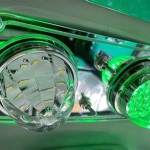How To Clean An Extremely Dirty Car Interior
An extremely dirty car interior presents a significant challenge for even the most diligent car owner. Neglect, accidental spills, accumulated dirt and debris, and the presence of mold or other contaminants can transform a vehicle's interior into an unpleasant and potentially unhealthy environment. Restoring the interior to a presentable and sanitary condition requires a systematic approach, specialized cleaning products, and considerable time and effort. This article provides a comprehensive guide to effectively cleaning an extremely dirty car interior.
Initial Assessment and Preparation
Before commencing the cleaning process, a thorough assessment of the interior's condition is essential. This involves identifying the specific types of dirt, stains, and contaminants present, as well as any areas of significant damage. The assessment will inform the selection of appropriate cleaning products and techniques. It is also crucial to gather all necessary supplies and equipment before starting. These include:
- A high-powered vacuum cleaner with various attachments (crevice tool, upholstery brush, etc.)
- Microfiber cloths (several)
- Interior cleaner suitable for various surfaces (vinyl, plastic, leather, fabric)
- Upholstery cleaner or stain remover
- Glass cleaner
- Leather cleaner and conditioner (if applicable)
- Detailing brushes (various sizes)
- A steam cleaner (optional, but highly effective)
- A carpet extractor (optional, for heavily soiled carpets)
- Rubber gloves
- Protective eyewear
- Trash bags
To prepare the vehicle for cleaning, remove all loose items from the interior, including floor mats, trash, personal belongings, and any other objects that may obstruct access to surfaces. Discard any trash and organize the remaining items outside of the vehicle.
Deep Cleaning the Interior Surfaces
The core of cleaning an extremely dirty car interior lies in systematically addressing each surface, employing appropriate cleaning agents and techniques. This process typically involves the following steps:
Vacuuming: Begin by thoroughly vacuuming the entire interior, including the carpets, upholstery, headliner, dashboard, console, door panels, and any crevices or hard-to-reach areas. Use the crevice tool to remove debris from seams and tight spaces. Pay particular attention to areas with heavy soiling or visible debris. Vacuuming removes loose dirt and debris, preparing the surfaces for further cleaning.
Dashboard and Console Cleaning: The dashboard and console surfaces often accumulate dust, grime, and fingerprints. Apply an interior cleaner specifically formulated for vinyl and plastic surfaces to a microfiber cloth and gently wipe down these areas. Use detailing brushes to reach crevices and intricate areas. Avoid spraying cleaner directly onto electronic components. Wipe away any excess cleaner with a clean, dry microfiber cloth. For stubborn stains or grime, a slightly stronger cleaner may be necessary, but always test it in an inconspicuous area first to ensure it does not damage the surface.
Door Panel Cleaning: Door panels typically consist of a combination of vinyl, plastic, and fabric. Use an appropriate interior cleaner for each material. Vacuum the fabric sections of the door panels before cleaning them with upholstery cleaner. For vinyl and plastic sections, follow the same cleaning procedure as for the dashboard and console. Pay attention to the door handles, armrests, and any other areas that are frequently touched. These areas tend to accumulate grease and dirt.
Upholstery Cleaning: Upholstery cleaning is a crucial step in restoring the interior of an extremely dirty car. The specific cleaning method will depend on the type of upholstery (fabric or leather). For fabric upholstery, apply an upholstery cleaner or stain remover according to the manufacturer's instructions. Use a detailing brush to work the cleaner into the fabric, paying attention to any stains or heavily soiled areas. Allow the cleaner to dwell for the recommended time, then blot the area with a clean, dry microfiber cloth. Repeat as necessary until the stain is removed. For heavily soiled upholstery, a carpet extractor may be necessary. This machine sprays cleaning solution onto the fabric and then extracts the dirty water, leaving the upholstery clean and dry. For leather upholstery, use a leather cleaner specifically formulated for automotive use. Apply the cleaner to a microfiber cloth and gently wipe down the leather surfaces. Avoid using harsh chemicals or abrasive cleaners, as these can damage the leather. After cleaning, apply a leather conditioner to help moisturize and protect the leather. This will prevent it from drying out and cracking.
Carpet Cleaning: Car carpets often bear the brunt of dirt, mud, and spills. Vacuum the carpets thoroughly to remove loose debris. Apply a carpet cleaner or stain remover to any stains or heavily soiled areas. Use a detailing brush to work the cleaner into the carpet fibers. Allow the cleaner to dwell for the recommended time, then blot the area with a clean, dry microfiber cloth. For heavily soiled carpets, a carpet extractor is the most effective cleaning method. After cleaning, allow the carpets to dry completely before replacing the floor mats.
Headliner Cleaning: The headliner is a delicate surface that can be easily damaged. Use a gentle upholstery cleaner and a soft microfiber cloth to clean the headliner. Avoid using excessive moisture, as this can cause the headliner to sag. Gently blot the surface, working from the center outwards. Allow the headliner to dry completely before driving the vehicle.
Window and Mirror Cleaning: Clean all windows and mirrors with a glass cleaner. Spray the cleaner onto a microfiber cloth and wipe down the surfaces. Use a separate clean, dry microfiber cloth to buff the glass to a streak-free shine. Pay attention to the corners and edges of the windows.
Addressing Specific Issues
In addition to general cleaning, specific issues may require targeted treatments. These include:
Odor Removal: Lingering odors can be a persistent problem in a dirty car interior. Common causes of odors include spilled food, pet accidents, and mold or mildew growth. To remove odors, identify the source of the odor and address it directly. Clean any affected surfaces thoroughly. Use an odor eliminator spray to neutralize lingering odors. In severe cases, an ozone generator may be necessary to eliminate persistent odors. Ensure the vehicle is unoccupied during ozone treatment and properly ventilated after the treatment is complete.
Mold and Mildew Removal: Mold and mildew growth can occur in damp or humid environments. If mold or mildew is present, it is crucial to address it promptly to prevent further spread and potential health risks. Wear protective gloves and eyewear when cleaning mold or mildew. Use a mold and mildew cleaner specifically formulated for automotive use. Apply the cleaner to the affected areas and scrub with a detailing brush. Wipe away any residue with a clean, damp cloth. Allow the area to dry completely. In severe cases of mold or mildew growth, professional remediation may be necessary.
Stain Removal: Stubborn stains may require specialized stain removers. Identify the type of stain before selecting a stain remover. Test the stain remover in an inconspicuous area before applying it to the entire stain. Follow the manufacturer's instructions carefully. Blot the stain with a clean, dry microfiber cloth. Avoid rubbing the stain, as this can spread it further. Repeat as necessary until the stain is removed.
Final Touches and Maintenance
Once the interior has been thoroughly cleaned, a few final touches can enhance the overall appearance and protect the surfaces. Apply a vinyl protectant to the dashboard, console, and door panels to help prevent fading and cracking. Apply a leather conditioner to leather upholstery to keep it supple and moisturized. Replace the floor mats with clean or new ones. Air fresheners or car fragrances can be used to provide a pleasant scent. To maintain the cleanliness of the car interior, regular vacuuming and spot cleaning are essential. Promptly address any spills or stains to prevent them from setting in. Regularly wipe down the dashboard, console, and door panels. Consider using seat covers to protect the upholstery from wear and tear.

How To Super Clean Your Interior Dashboard Center Console Door Panels Glass

Deep Cleaning The Most Insanely Dirty Car

How To Clean Super Dirty Door Panels And Interior Plastic Great Results

How To Super Clean Cloth And Leather Seats

How To Clean A Car Interior In 8 Simple Steps

How To Clean Your Car S Exterior And Interior

10 Tips To Remove Stains From Your Car Seats

How To Clean Interior Plastic Autobead

How To Clean Car Seats

Best Homemade Car Interior Cleaner Diy Tips For A Spotless Ride Everyday Skate
Related Posts








